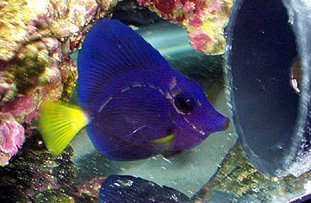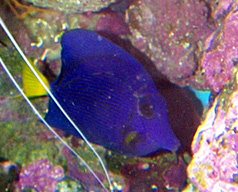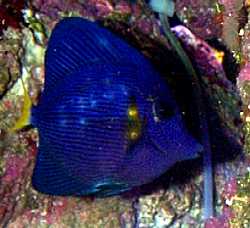aka Purple tang

After drip acclimation the tang was placed in the hospital and the lights were turned off for most of the afternoon. Later in the day the 20 watt NO fluorescent bulb was turned on to illuminate the hospital and prepare the fish for feeding.


Fearing that this animal would not eat, I began to become concerned. I finally saw it pick at the Vibragro that had fallen to the bottom of the tank. I hastily soaked some more of these in Zoe, a vitamin additive and as an afterthought I added some of the spirulina flakes and shredded seaweed. Finally the animal ate like a horse. A seahorse that is ;)

Fin damage is showing signs of healing. I've madeup a mixture of nori, vibragro and spirulina flakes soaked in Zoe. Added RO water and froze the mixture. Chunks of this are fed several times per day. Additional nori is fed throughout the day.
Jan 11/99
The fish is now accepting some frozen brine shrimp along with the other food offered.
Jan 12/99
It is impossible to tell where the dorsal fin damage was. All is healed and returned to full color.
Jan 13/99
The fish is now accepting nori from a veggie clip. There was some initial fear of the clip. By placing nori on the clip before the first feeding of the day the animal was willing to take the risk and eat from the clip. Perhaps it is wishfull thinking, but it appears that the LLE is starting to break up in places.
The tang was added to the main tank this evening. The benefits of this decision were more swimming space for the tang, natural food sources and the attention of two cleaner shrimp (lysmata amboinensis), skunk cleaners.
The first ten minutes in the main tank were spent being serviced by the skunk cleaners. This was followed by a feeding and some exploration.
The are some lessons to be learned from this experience. A hospital or quarantine tank is not all that difficult to setup or maintain. I am not sure I'll be making any further fish additions to my reef aquarium, but if I do they'll definitely be quarantined.
A larger fish would have required more tank space, but this 2.5 inch tang did not show any signs of stress from the six days spent in a 5 gallon tank. I would not recommend this treatment for a healthy fish, nor for very long regardless of the state of the animals health.
The hospital allowed close observation and the ability to confirm that the specimen is eating, free of parasites and finally, when it is healthy. I can imagine a sick fish in a large tank would find many places to hide making it difficult for the aquarist to make useful determinations.
The next photo update will be made on Jan 23/99 so please check back then.
See new photo above. The tang is still eating well, depriving it's tank mates of food and getting fat in the belly. The LLE along the line of the back is improving, but the erosion around the eyes is slow to heal.
On occassion I have noticed white patches on the fins and body of the fish. These are roughly round and have a radius of about 1/2 cm. They disappear within 12 hours of my noticing them.
I suspected that these might be due to interaction with the business end of an anemone. A small e. quad and tomato clown own one end of the tank, but the tang is often seen very near the anemone. A regular poster to reefkeepers suggested that the white patches were symptoms of cyanide or quinine poisoning. (Thanks Phishmon).
If I can get a better photo through the week I'll add it, otherwise the next photo update will be made on Feb 6/99.

New photo shows that the LLE continues to improve. The interesting thing in this photo is the white blotches on the fish. These are from an interaction with a bubble tipped anemone. This turkey tang thinks it is a clown fish. It has swam into the anemone on a number of occasions. The white discolorations clear up within a couple of hours.
Just a quick update for those still following the plight of this fish. After numerous stings from a bulb tip anemone the tang began showing signs of ich. Before it became a serious issue I decided to move the fish to a hospital tank. To do so I had to break down the reef!
Two weeks of the hospital has worked wonders for the animal. There have been no signs of ich or the white blotching. The absence of white marks proves to me that they were the result of anemone stings. The fish will stay in the hospital another week or so to be certain that the ich has run it's course.
I'll be glad when the daily five gallon water changes are over...
Just a quick update for those still following the plight of this fish. After numerous stings from a bulb tip anemone the tang began showing signs of ich. Before it became a serious issue I decided to move the fish to a hospital tank. To do so I had to break down the reef!
Two weeks of the hospital has worked wonders for the animal. There have been no signs of ich or the white blotching. The absence of white marks proves to me that they were the result of anemone stings. The fish will stay in the hospital another week or so to be certain that the ich has run it's course.
I'll be glad when the daily five gallon water changes are over...